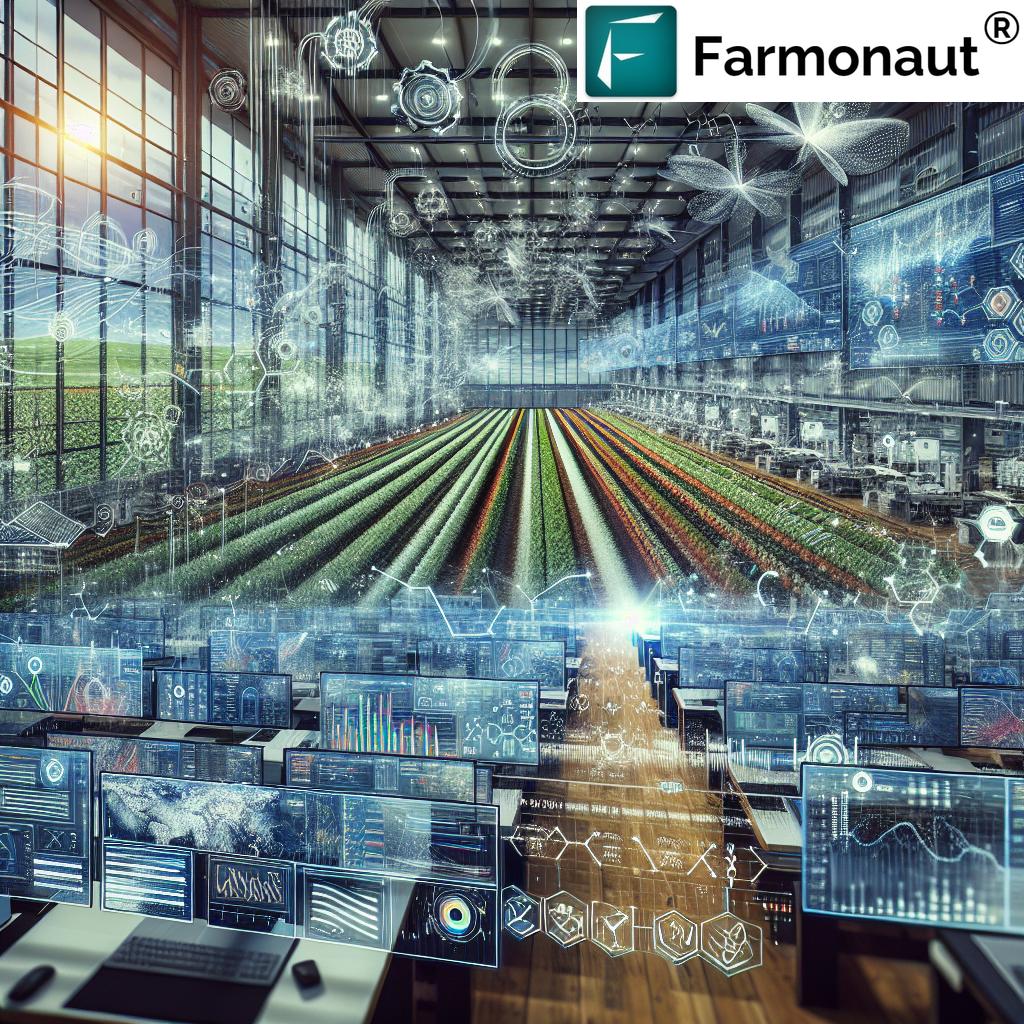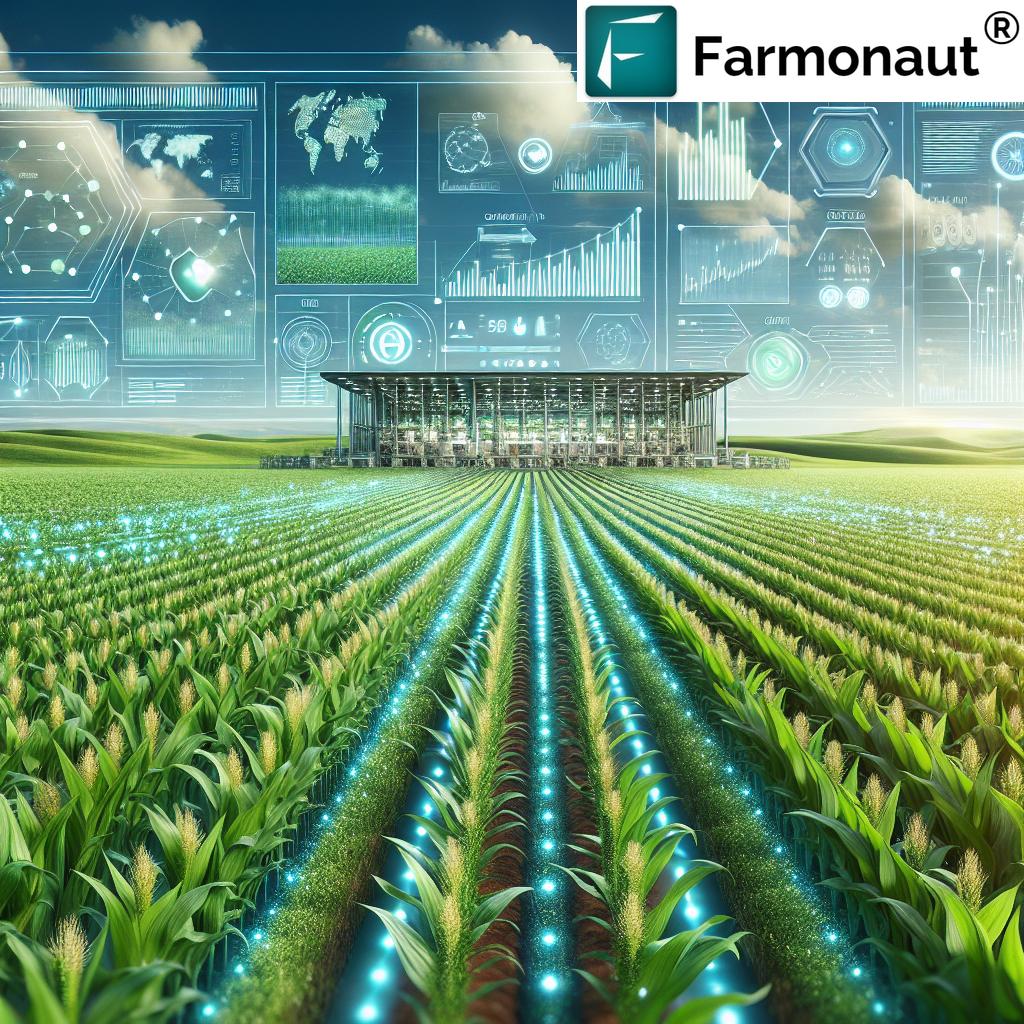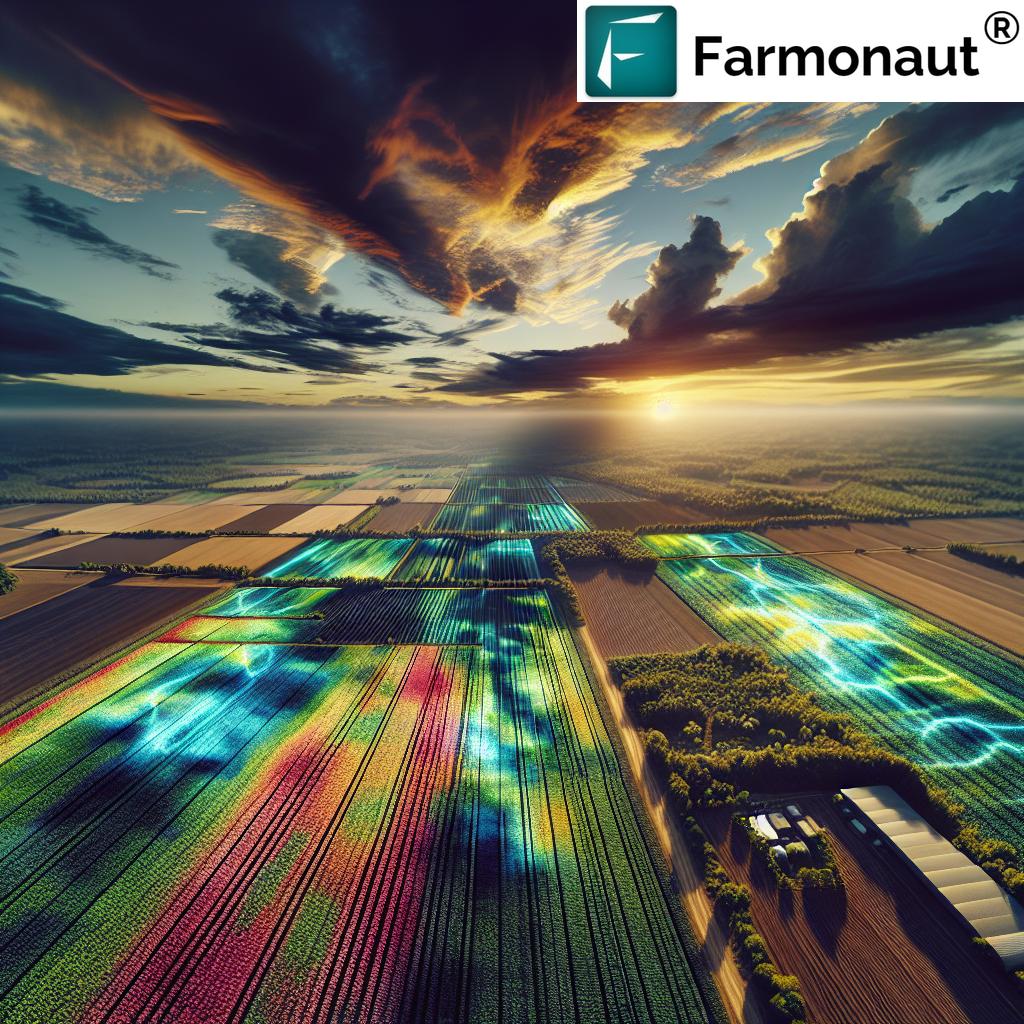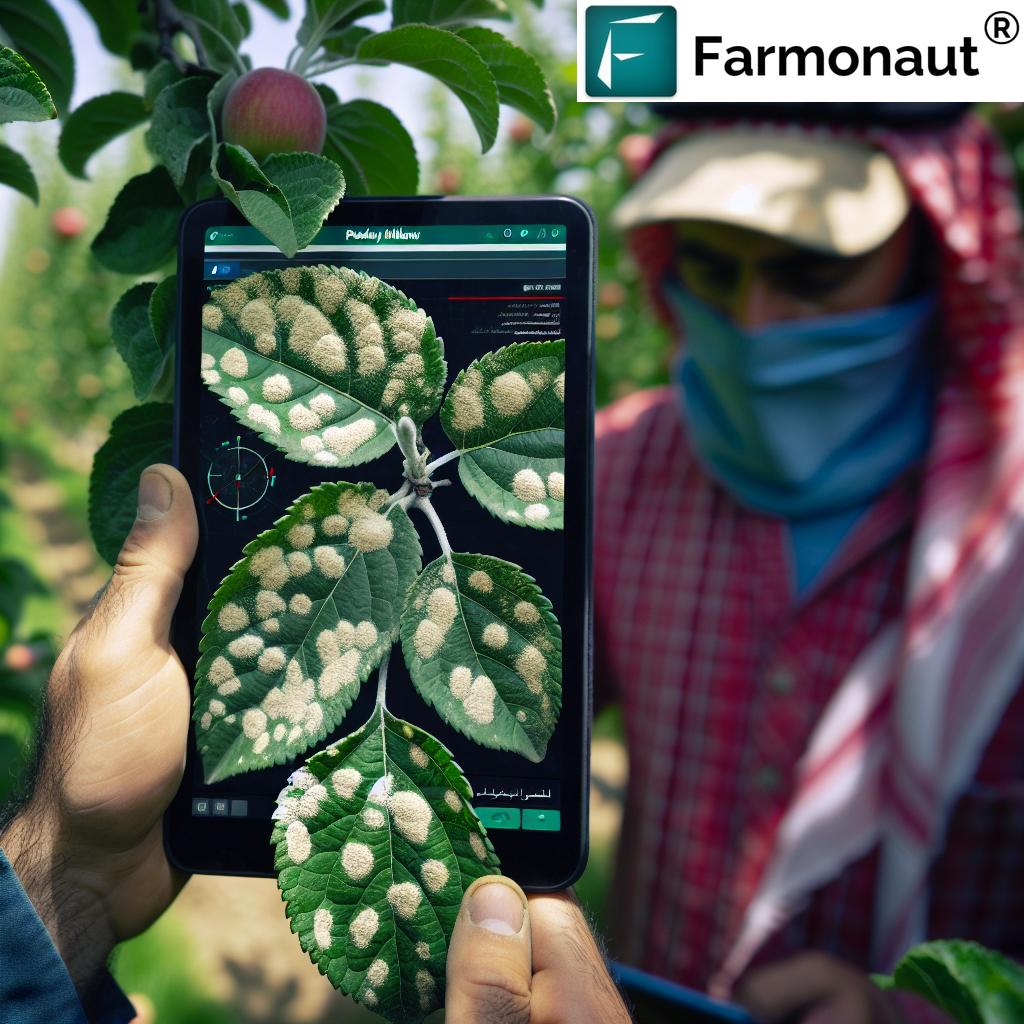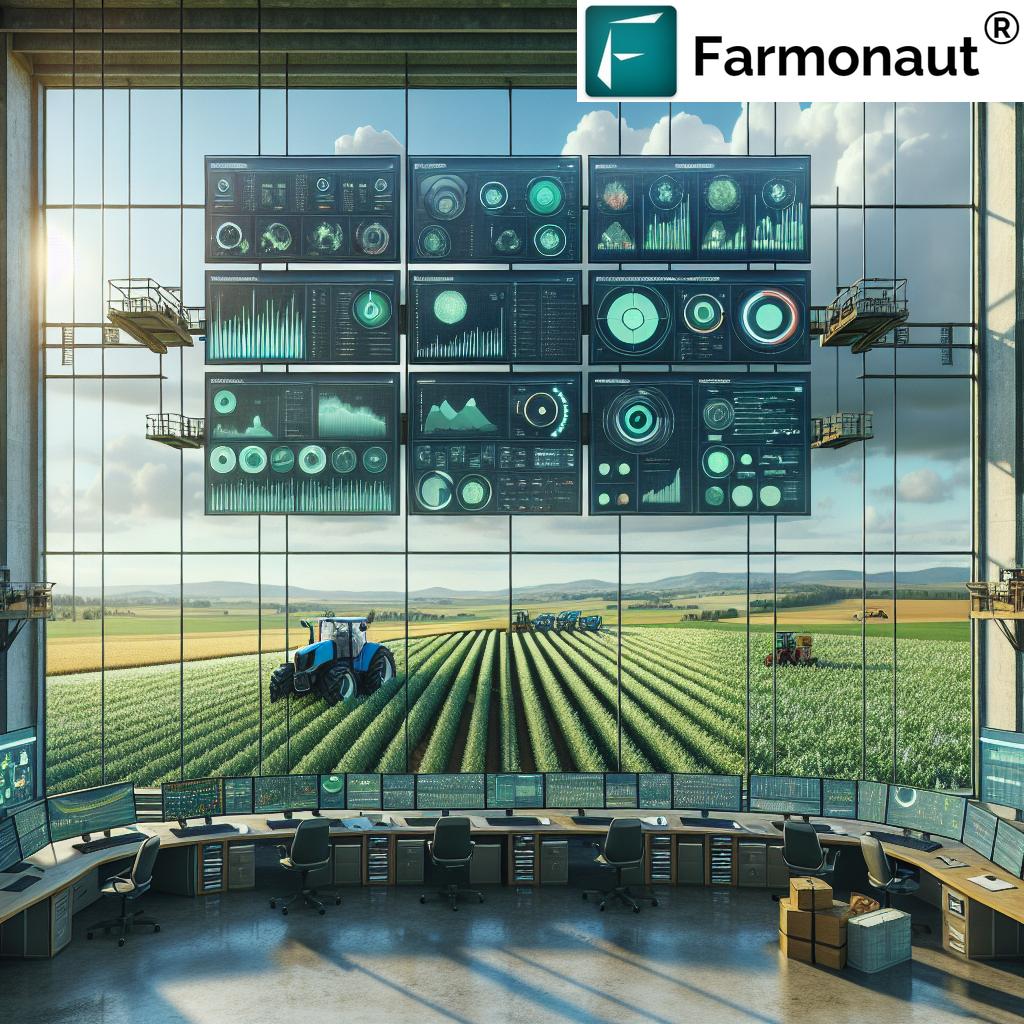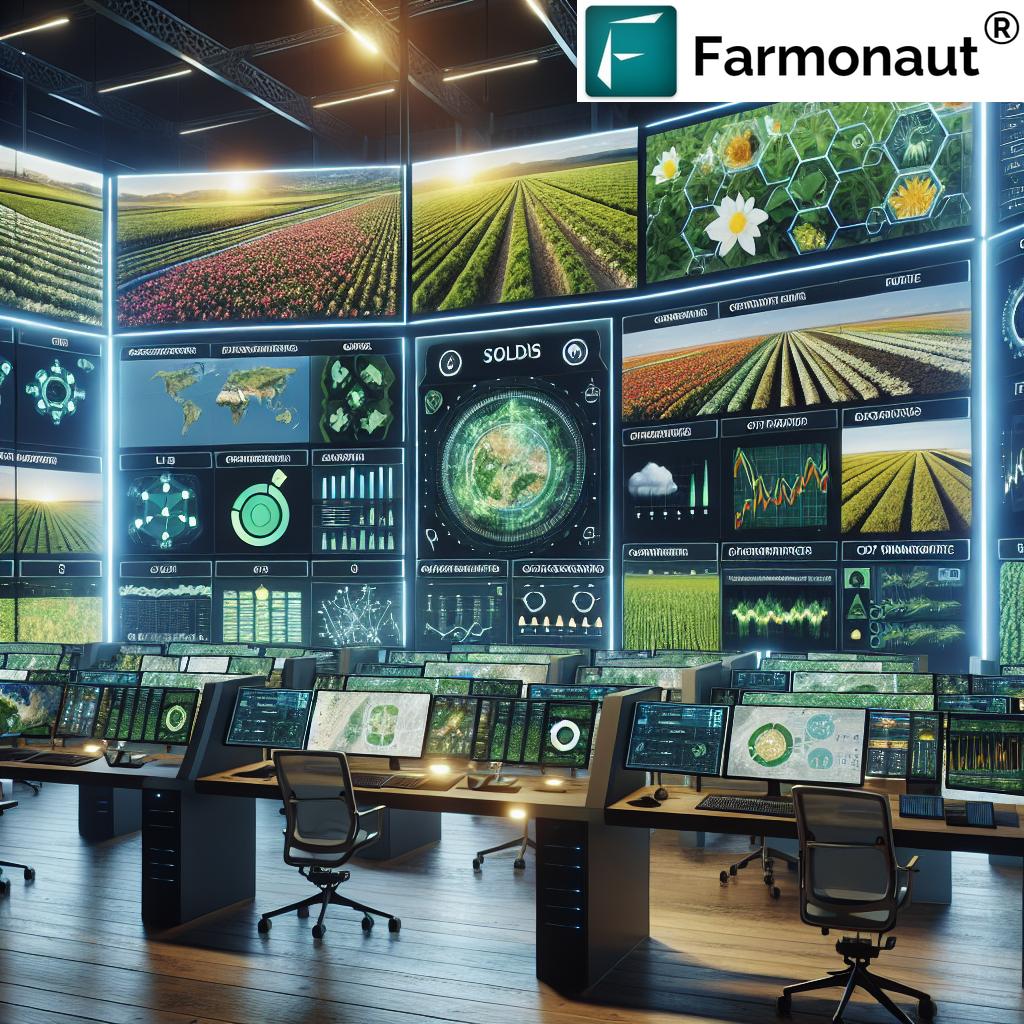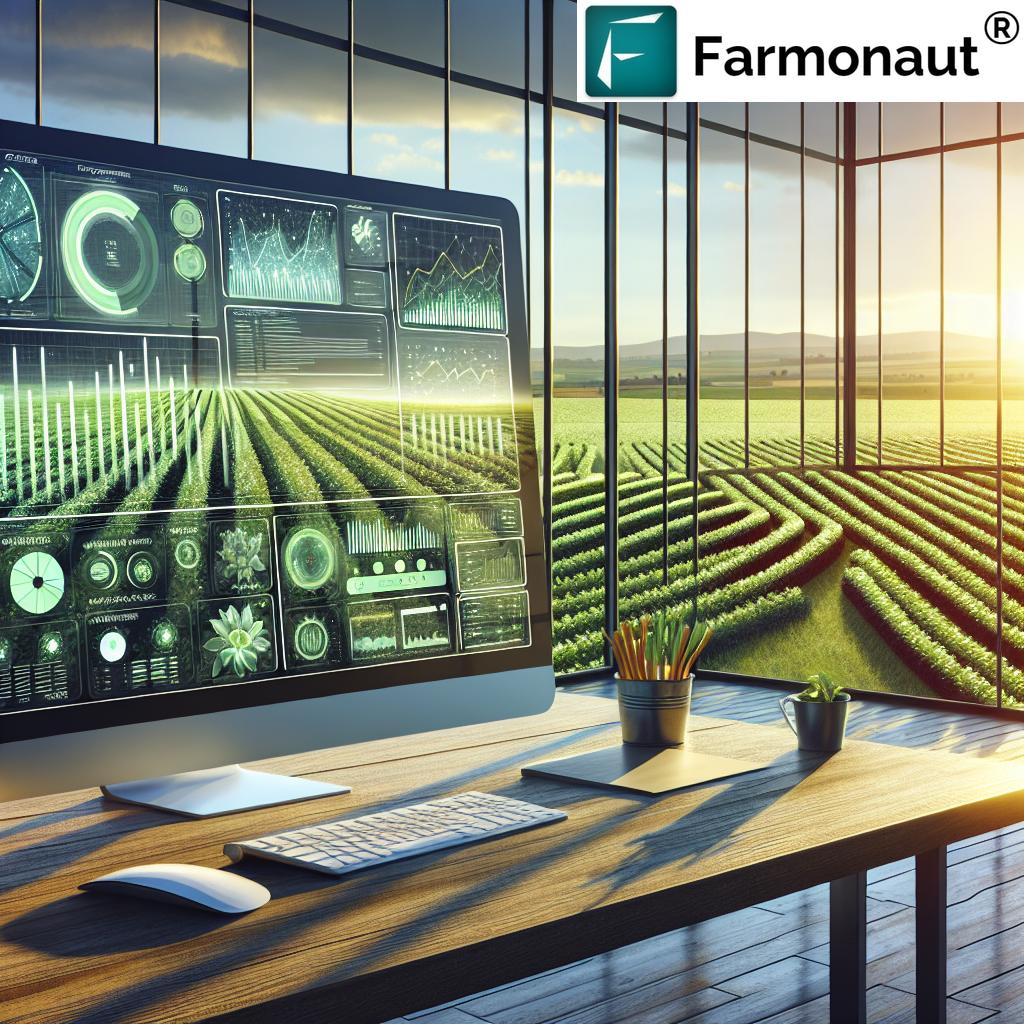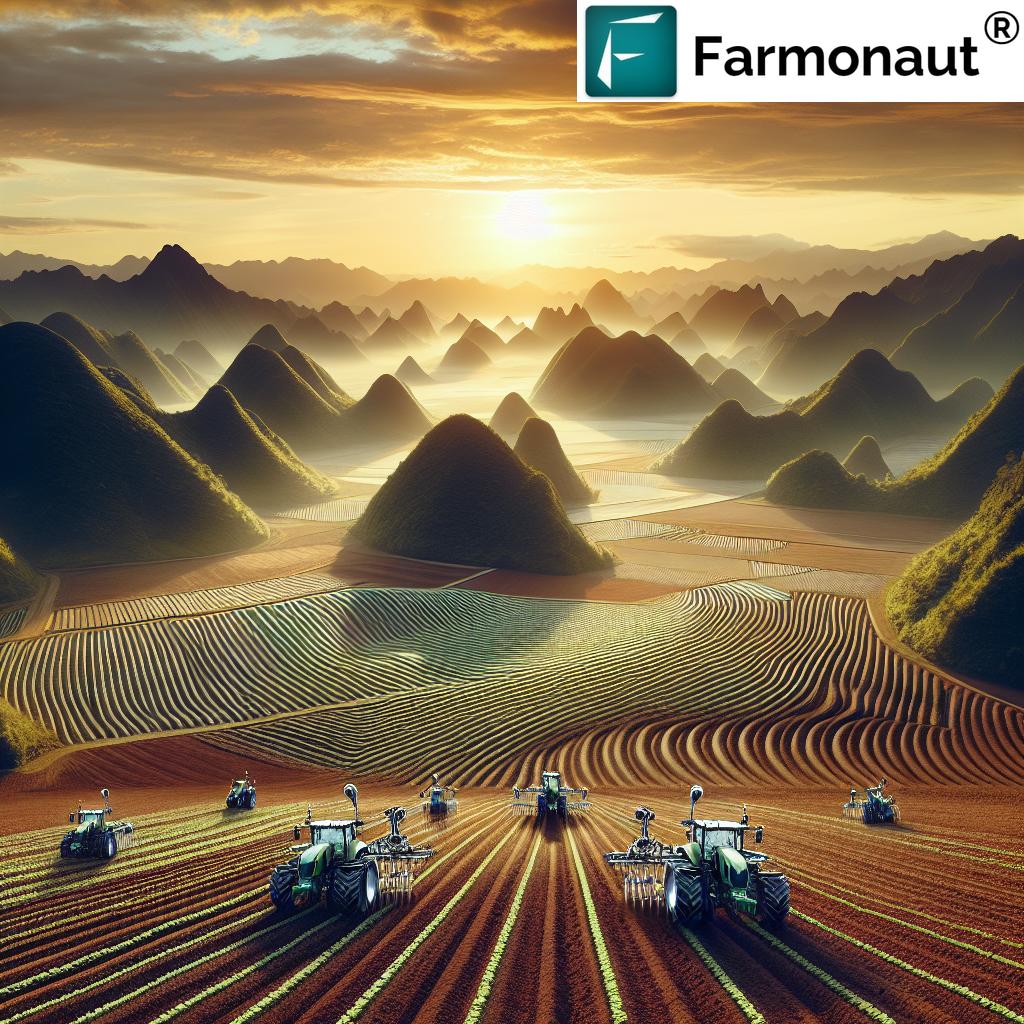Smart Digital Farming: 7 Techs Boosting Yields
“AI-driven analytics can increase crop yields by up to 30% through precise data-driven decisions in digital farming.”
Summary: Revolutionizing Agriculture for a Sustainable Future
The agricultural sector is experiencing unparalleled transformation through smart digital farming. By integrating IoT in agriculture, artificial intelligence in farming, and big data analytics for farmers, this new wave of technology is driving increased productivity, ensuring crop yield optimization, and building a more sustainable global food system. Embracing digital agriculture solutions—from advanced sensors and robotics to scalable farm management apps—enables farmers to make informed, data-driven decisions while conserving precious resources. Read on to explore the most impactful innovations and how we, at Farmonaut, simplify precision agriculture for everyone.
Understanding Smart Digital Farming
Smart digital farming—often called Agriculture 4.0—merges technologies like the Internet of Things (IoT), artificial intelligence (AI), machine learning, robotics, and big data analytics to modernize agriculture. Connected devices and sensors collect priceless, real-time data on soil, weather, and crop conditions, allowing farmers to optimize operations and promptly take informed actions.
These innovations achieve more than just better yields: they enable sustainable agricultural practices by minimizing resource consumption, streamlining operations, and reducing environmental impact. By leveraging powerful data analytics tools, farming becomes a data-rich, precise process—one where weather forecasting, disease prediction, soil health monitoring, pest control, and resource management are all seamlessly integrated.
We, at Farmonaut, empower every farm—from smallholders in India to large agribusinesses worldwide—with cost-effective, digital agriculture solutions. Through accessible satellite-based apps and APIs, we help farmers embrace data-driven farming practices for improved sustainability and profitability.
“Big data adoption in agriculture is projected to reach $1.4 billion globally by 2025, revolutionizing farm management.”
7 Key Technologies in Smart Digital Farming
Let’s explore the seven transformative technologies enabling crop yield optimization, resource conservation, and sustainable agricultural practices around the globe.
1. Internet of Things (IoT) Sensors & Devices
IoT in agriculture transforms fields into smart, responsive ecosystems. Sensors and actuators are deployed throughout fields to collect granular data on soil moisture, temperature, humidity, nutrients, and microclimate factors. This collaborative data collection enables precise irrigation, fertilization, and pest control.
- Use: Real-time monitoring of soil, crops, and environment.
- Benefits: Reduces water usage (irrigation control), minimizes fertilizer and pesticide waste, and automates corrective actions.
- Example Devices: Soil moisture sensors, weather stations, smart irrigation controllers.
In Indian wheat farms, for instance, IoT-enabled irrigation systems have shown to save 30% more water compared to traditional methods.
2. Artificial Intelligence (AI) and Machine Learning
AI is the brain of digital agriculture. Artificial intelligence in farming solutions rely on algorithms that process large amounts of sensor data, historical records, and external sources to predict diseases, optimize planting schedules, and recommend specific treatment plans for crops.
- Enables pathways for precision agriculture technologies that can adjust recommendations as new data becomes available.
- Helps identify early warning signs of disease—increasing recovery rates and minimizing chemical interventions.
- Guides resource allocation, reducing costs while maximizing productivity.
We provide AI-driven farm advisory via our Jeevn AI system to analyze weather, crop health, and resource needs—all in real-time, driving actionable insights straight to farmers’ smartphones.
3. Robotics and Automation in Farming
Robotics and automation in farming are revolutionizing how labor-intensive tasks are handled. Autonomous tractors and robotic harvesters utilize machine vision and AI to perform precision planting, targeted weeding, fertilization, and pest control much faster—and with fewer human errors.
- Decreases dependence on manual labor, reducing errors and risk of injury.
- Ensures efficient scheduling and implementation of farm activities, promoting sustainability and lower operational costs.
- Autonomous drones can monitor crops, survey large fields, and distribute treatment only where needed.
These systems are particularly beneficial in regions facing labor shortages or where large-scale operations require round-the-clock monitoring and timely interventions.
4. Big Data Analytics: The Brain Behind Smart Agriculture
Big data analytics for farmers involves ingesting and analyzing historical, current, and predictive data on everything from weather to market prices. Insights drawn from such analysis empower farmers to:
- Optimize resource application for water, fertilizers, and pesticides.
- Identify anomalies or stress zones in large fields.
- Forecast yields, enabling better supply chain and market decisions.
With global agricultural data growing exponentially, these tools are a linchpin for sustainability and efficiency. The ability to harness big data for customizable insights helps farmers respond proactively to changing conditions.
5. Blockchain Technology for Food Traceability and Security
Blockchain introduces transparency, security, and traceability into the food supply chain. By recording every transaction—seed, crop growth, transportation, processing—on a secure, decentralized ledger, blockchain technology:
- Ensures: Ethical sourcing and transparent supply chains; manufacturers, certifiers, and consumers can verify every step.
- Protects: Data privacy and product authenticity, reducing fraud and food safety risks.
- Enhances: Consumer trust by ensuring traceable, safe, and quality food products.
We offer blockchain-based traceability solutions for tracking agricultural product origins, reinforcing supply chain integrity and compliance for our global corporate clients.
6. Satellite Imaging & Remote Sensing
Satellite imagery offers a bird’s-eye view for continuous field monitoring over large areas. These advanced technologies provide actionable data on:
- Crop health indices (e.g., NDVI) for early detection of plant stress, diseases, or pest infestations.
- Soil moisture variations, irrigation needs, and targeted intervention zones.
- Planting density, growth rates, and yield estimation at scale.
Our platform uniquely harnesses satellite remote sensing for affordable crop monitoring, available via large-scale farm management tools. From smallholder plots to vast plantations, this data-driven perspective ensures resources are focused where most needed, enhancing productivity and conservation.
7. Cloud & Mobile Farm Management Platforms
Powerful digital platforms consolidate fields of data and provide farmers with intuitive dashboards for monitoring, record-keeping, and analysis. These platforms enable:
- Seamless integration of IoT, satellite, and market data for complete situational awareness.
- AI-driven advisory to optimize fertilization, irrigation, and crop rotation schedules.
- Mobile-friendly accessibility—farmers can analyze, control, and respond on-the-go, improving retention of data-driven practices.
Our Farmonaut Android, iOS, Web, and API solutions are designed for accessibility—helping everyone, from smallholders to global agribusinesses, adopt smart digital farming without the barrier of expensive hardware.
Explore satellite & weather APIs for developers or view full API developer docs for custom integrations.
Comparative Technology Impact Table: Smart Digital Farming
| Technology Name | Core Function | Estimated Yield Increase (%) | Sustainability Benefit | Adoption Level |
|---|---|---|---|---|
| IoT Sensors & Devices | Real-time data collection and monitoring of soil, crops, and environment | 15–25% | Reduces water and input waste, conserves resources | Medium–High |
| AI & Machine Learning | Predictive analytics for disease detection, crop management, and precision treatment | 20–30% | Enables targeted interventions, reduces chemical usage | Medium |
| Robotics & Automation | Automated & autonomous farming operations: planting, weeding, harvesting | 10–20% | Minimizes labor, lowers energy use, increases precision | Low–Medium |
| Big Data Analytics | Analyze large datasets for trends, forecasting, and optimization | 15–25% | Improves decision-making, drives efficient operations | Medium |
| Blockchain Technology | Secure, transparent tracking of products across the supply chain | 5–10% | Boosts food security and consumer trust | Low |
| Satellite Imaging | Remote sensing for crop health, soil moisture, yield estimation | 10–25% | Covers large areas, enables large-scale sustainability | Medium |
| Cloud & Mobile Platforms | Data-driven management and advisory via accessible mobile/web apps | 10–18% | Promotes digital inclusivity and information sharing | High |
Benefits: Higher Yields, Lower Costs, Better Sustainability
The adoption of smart digital farming delivers quantifiable improvements across all stages of production. Let’s examine the core benefits:
- Increased Efficiency: Integrated systems automate repetitive tasks, streamline resource allocation, and provide informed decisions on irrigation, fertilization, and planting schedules—to maximize productivity.
- Enhanced Crop Yields: Precision agriculture technologies and spatial analysis lead to more even crop emergence, better spacing, healthier plants, and higher yields.
- Sustainable Practices: Minimized pesticide and fertilizer runoff, precise water management, and optimal field practices preserve soil structure and local biodiversity while reducing environmental impact.
- Cost Savings: Reduced input waste, automation of labor, and tailored recommendations contribute to significant cost savings over time—offsetting any initial investment in technology.
- Data-driven Resilience: Big data analytics for farmers and timely insights enable rapid adaptation to pests, disease outbreaks, and changing climate conditions.
For agribusinesses seeking to advance their sustainability reporting and comply with environmental benchmarks, our carbon footprinting solutions offer real-time emissions monitoring and actionable strategies for lowering environmental footprint.
Challenges: Adoption and Implementation
While smart digital farming promises transformative results, adoption at scale is not without obstacles:
- High Initial Investment: Cutting-edge equipment, infrastructure (reliable internet, modern machinery), and software solutions demand upfront spending—often a significant barrier for small and medium-scale operations.
- Digital Literacy: Introducing advanced technologies into traditional farm settings requires training and ongoing support for farmers less familiar with digital devices.
- Data Security & Privacy: Increasing connectivity exposes agriculture to cyber threats. IoT devices and cloud-based systems must be secured against breaches, ensuring privacy and maintaining trust among users.
- Infrastructure Requirements: Building adequate IoT infrastructure, such as satellite links, high-speed data, and robust cloud storage, can be cost-prohibitive in rural or remote locations.
Despite these challenges, the long-term cost savings, efficiency gains, and evolving policy incentives are making digital agriculture more accessible worldwide.
For those needing assistance with farm compliance, crop loan and insurance eligibility can be quickly verified through satellite data—removing paperwork burdens and enabling instant verification for banks and insurers.
Global Initiatives & Future Outlook: The Path Ahead for Smart Digital Farming
Countries and regions are investing heavily in smart digital agriculture to ensure future food security:
- China: Embarked on a 2024–2028 digital agriculture action plan with the aim to build a unified big data platform and introduce AI, GPS, and satellite technologies across planting, irrigation, and harvesting operations.
- India: Smallholder farmers empowered with AI-powered advisory and toolkits are showing improved climate resilience, lower debts, and higher profits—leading to expansion of these initiatives across Asia, Africa, and Latin America.
- World Over: Industry projections indicate the market for big data in agriculture will reach $1.4 billion by 2025, fueling new innovations and digital adoption across continents.
The future of smart digital farming points toward full integration of AI, machine learning, IoT, and blockchain—along with new types of sensors and analytics—for highly adaptive, resilient, and sustainable agricultural practices. As technologies become more affordable and accessible, adoption rates will accelerate and the global food system will benefit in both output and resilience.
Farmonaut’s Role in Advancing Digital Agriculture Solutions
At Farmonaut, our mission is to democratize access to smart digital farming through cost-effective, satellite-driven, data-rich platforms that empower every stakeholder in the agricultural sector:
- Satellite-Based Crop Health Monitoring: Precise data on vegetation health (NDVI), soil moisture, and field anomalies lets farmers optimize irrigation, fertilization, and pest management for yield maximization and resource conservation.
- AI-Powered Jeevn Advisory: Personalized farm management advice, weather alerts, and crop health recommendations—delivered on-demand, making data-driven farming practices accessible to farmers everywhere.
- Blockchain-Based Traceability: Verifiable, secure food provenance from field to consumer—protecting brand reputation, ensuring compliance, and giving consumers confidence in their food sources.
- Resource & Fleet Management: Efficient management of agricultural fleets and logistics—lowering operational costs, enhancing safety, and streamlining all vehicle and equipment use.
- Carbon Footprinting and Environmental Reporting: Actionable, real-time emissions tracking so agribusinesses can quantify and reduce their environmental impact while meeting sustainability goals.
- Accessible Platforms & APIs: From Android & iOS apps to browser interfaces and developer APIs, our technology suite ensures smart digital farming is within reach for every farm, regardless of location or scale.
Our large-scale farm management tools and smart plantation advisory provide holistic, real-time control to boost productivity, secure financing, and scale operations smoothly.
The proven value for end-users? Better crop yields, lower costs, and a transparent, sustainable, and resilient food supply chain—for every farmer, business, and policy-maker.
Farmonaut Smart Digital Farming Subscription Plans
FAQs: Smart Digital Farming
What is smart digital farming?
Smart digital farming is the integration of advanced technologies like IoT, artificial intelligence, big data analytics, and automation into everyday agricultural practices. It enables farmers to collect and analyze data about their crops, soil, and environment, making decisions that improve yields, lower costs, and ensure sustainable resource use.
Why is IoT important in agriculture?
IoT in agriculture provides the backbone for real-time monitoring, remote control, and automation of farming operations. Sensors collect environmental data like temperature, humidity, and soil moisture, allowing for precise irrigation, targeted fertilization, and early detection of threats—directly increasing efficiency and reducing resource waste.
How does artificial intelligence benefit farmers?
AI in farming processes large amounts of agricultural data, making complex predictions about crop health, pest risk, and optimal treatment schedules. This leads to faster decision-making, higher yields, and better management of unexpected events (like disease outbreaks or weather changes).
Are smart digital farming solutions expensive?
While the initial investment can be significant—costing for hardware, infrastructure, or platform subscriptions—smart digital farming has proven long-term cost savings through higher productivity, lower resource input, and reduced labor needs. Platforms like Farmonaut, leveraging satellite and cloud technologies, are specifically designed to lower the cost barrier and make precision agriculture accessible to all sizes of farms.
Is my data secure in digital agriculture platforms?
Security and privacy are core to responsible digital agriculture. Leading platforms employ robust encryption, secure data storage, and privacy compliance to dispel risks. Blockchain integration adds an additional layer of transparency and tamper-resistance for critical supply chain data.
How do digital agriculture solutions support sustainability?
They support sustainability by ensuring optimal resource use—delivering the right amount of water, fertilizer, or pesticide only where needed—while monitoring and reducing the farm’s environmental impact. Carbon footprinting and traceability initiatives further promote responsible and climate-friendly farming.
Can smallholder farmers benefit from smart digital farming?
Absolutely. With mobile-friendly apps, affordable satellite monitoring, and simplified AI-driven advisory, even smallholder farmers can access the benefits of data-driven precision agriculture—boosting yields and reducing losses in a scalable manner.
Conclusion
Smart digital farming is redefining the very core of agriculture—delivering solutions firmly rooted in data, technology, and innovation. By merging IoT sensors, AI-driven analysis, big data, automation, and blockchain, farmers and agribusinesses now have unprecedented control over every facet of production, sustainability, and profitability.
We, at Farmonaut, believe in breaking down barriers to digital transformation in agriculture. With our satellite-powered platforms, AI insights, and blockchain-backed transparency solutions, farmers and enterprises across the globe can optimize yields, cut costs, protect their environment, and build resilient food systems for the future.
Ready to take your agriculture to the next level? Start using Farmonaut digital solutions today—for smarter decisions, sustainable growth, and a healthier planet.






